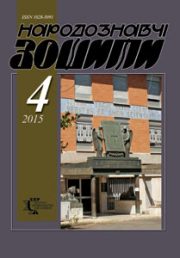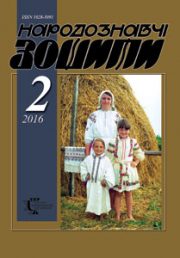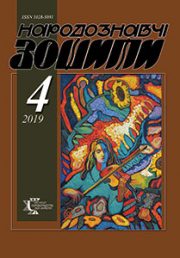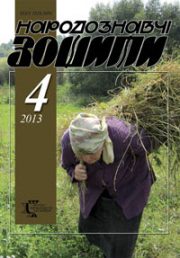The Ethnology Notebooks. 2020. № 1 (151), 126—137
UDK[745.51.021.32.071.1:39](477.86/.87=161.2)
DOI https://doi.org/10.15407/nz2020.01.126
THE ANCIENT ART OF WOOD CARVING OF BOYKOS: ARCHAIC MONUMENTALITY AND «PAINTING» GEOMETRY
BOLYUK Oleh
ORCID ID: https://orcid.org/0000-0002-8292-202X
Candidate of Arts (Ph. D),
Researcher at Folk Art Department of Ethnology
Institute of NAS of Ukraine
15, Svobodyave., 79000, Lviv, Ukraine
Contacts: e-mail: oleh.bolyuk@gmail.com
Abstract. Artistic wood creations of Boykos is an important marker of ethnic identity of the Ukrainian group and national cultural signs in general, because their study will always be relevant. The main purpose of the article was popularization of aesthetic preferences of Boyko Masters, which resulted in their expressive works of art of Wood Carving. The subject of the investigation is evolution, types, functions and other criteria of the local artistic phenomenon. Creation shows the artistic taste of folk masters, which includes some plastic or ornamental features, which focused attention as the object of the study.
To complete the task and achieve the designated goal it was used the method of formal analytical comparison of wooden works of Boykos. The article is based on a systemic approach, creative and emotional activity of master carvers. Art analysis showed specificity of aesthetic phenomenon of carved items and decoration of dimensional structures in ethnographic Boikivshchyna. Its feature is determined by concise decor; a limited list of the most common reasons of carving; Seizure of geometrical shapes and patterns, but avoiding of precise geometry of the composition. However, the actual performance authenticatesBoyko master as an artist, not a thorough compiler of fragments of the universal ornament. This kind of «picturesque graphic» of Boykos Carving is particularly noticeable in small decor nuances. It is reflected in many semantic signs, including details printed on Christian places of worship. Elements of universal carved ornamentation (circles, rosettes, carved bands etc.) didn’t lose significance during Christianization, although the main focus of the new religion of art focused on the symbol of the cross.
It is proved that in comparison with its neighbors — Hutsuls and Lemkos, Boykos are conservative, based on which shaped their pragmatism, including the practice of carving.
The scientific value of article is a supplement knowledge about cultural heritage of the Ukrainian ethnic group in the social, anthropological, cultural and art dimensions. Attention is paid to the types of woodcarving, local artistic preferences and product range of Ukrainian mountaineers. Chronological retrospective made it possible to trace individual sustainability of creative ideas and their modern interpretation.
The author stated that in the first third of the twentieth century in Boikivshchyna was applied contour carving on the toned surface, which is filled with aniline paints. It is noticed that the last decade of the XX — beginning of XXI century is a period of carving individual practices. The current stage of artistic carving area is Boikivshchyna experimental search, but at the level of professional theoretical knowledge and creative skills.
The information is practical impulse for popularizing traditional Ukrainian art as a marker of ethnic identity in the modern process of total globalization.
Keywords: carving motifs, wooden products, Boykos, Boіkivshchyna.
Received 11.01.2020
REFERENCES
Hoshko, Y. (Ed.). (1983). Boikivshchyna: historical and ethnographic studies. Kyiv: Scientific Thought [in Ukrainian].
Bolyuk, O. (2015). Wooden products and their flat carvings on the toned surface in the Ukrainian church, topography and motives in the interior ornaments. In: History of Religions in Ukraine: Research edition (Pp. 424—432). Lviv: Institute of Religious Studies; Logos [in Ukrainian].
Bolyuk,O. (2019). Contour polychrome carving as a local ethnic identity marker of western Ukrainians. Yesterday’s Cultural Heritage — Implications for Sustainable Society Tomorrow. (International Scientific Conference) (P. 91). Project 19.00059.06.20F/MS, Strategic Direction «National Heritage and Society Development» (Part I).Chisinau [in Russian].
Bolyuk, O. (2018). Small architectural forms. In: Church art of Ukraine: in 3 vol. (Vol. 1, pp. 517—42). Kharkiv: Folio. Architecture. Monumental art [in Ukrainian].
Bolyuk, O. (2019). Methods of studying the art of wood during complex expeditions 1995—2017 on the territory of Western Ukraine. In: Sixth Platonic reading on the memory of academician P. Bielecki (1922—1998) devoted to the 20th anniversary of the death of P. Bielecki (P. 63). Kyiv, Ukraine Ministry of Culture; The National Academy of Fine Arts and Architecture [in Ukrainian].
Bolyuk, O. (2018). Profiles and carving arts. In: Church art of Ukraine: in 3 vol. (Vol. 1, pp. 543—592). Kharkiv: Folio. Architecture. Monumental art [in Ukrainian].
Budzan, A. (1960). Carving in the Western Ukraine (XIX—XX). Kyiv: Printed USSR [in Ukrainian].
Grabar, I. (1911). History of Ruthenian art (Vol. 2). Moscow: Ed. I. Knebel [in Russian].
Demian, G. (1991). Boikivshchyna talents. Lviv: Kameniar [in Ukrainian].
Kyssil, I. (1995). Ivan Ohienko about pre-Christian beliefs and their impact on the Ukrainian ethnic psychology. The Ethnology notebooks, 4, 209—212 [in Ukrainian].
Laurentian Codex in 1872, Publishing of Archaeological Commission [in Russian].
Zaharchuk Chugai, R. (Ed.). (1979). Shkribliak’s Family: Album. Kyiv: Art [in Ukrainian].
Rozhko, M. (1996). Tustan —Ancient rock fortress. Kyiv: Naukova dumka [in Ukrainian].
Stankevych, M. (2002). Ukrainian wood art of the XVI—XX centuries. Lviv: Institute of the National Academy of Sciences of Ukraine [in Ukrainian].
Taras, Y. (2007). Sacral wooden architecture of Ukrainian Carpathians: cultural and traditional aspect. Lviv: IN NAS [in Ukrainian].
Wooden Churches of Ukraine are a UNESCO World Heritage Site. Retrieved from: https://ua.igotoworld.com/ua/article/682_derevyannye-cerkvi-ukrainy-yunesko.htm [in Ukrainian].







